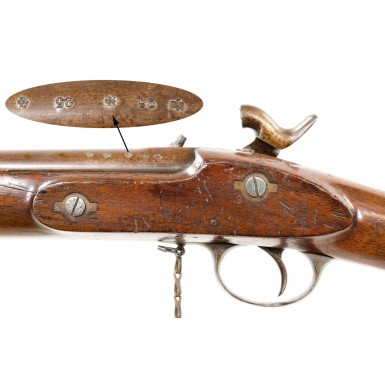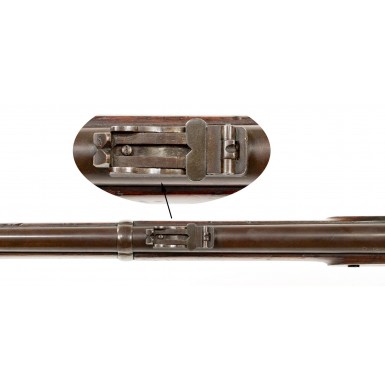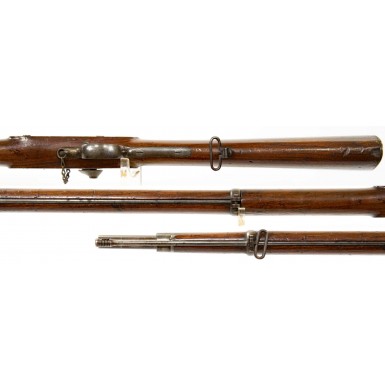British Pattern 1856 Sergeant's Fusil For India Service
- Product Code: FLA-3564
- Availability: In Stock
-
$3,995.00
In 1856, the British military adopted a new variant of the Pattern 1856 Enfield Infantry “Short” Rifle, the Sergeant’s Fusil, Rifled, Pattern 1856. According to the research of Dr. C.H. Roads in his outstanding book The British Soldier’s Firearm: From Smoothbore to Smallbore, 10,000 of these Sergeant’s Fusils were ordered from Birmingham contractors in late July of 1857 and by March of the following year 8,198 had been delivered to India for the use of sergeants of the Native Regiments. The gun was to weigh 9 pounds 8 ounces with bayonet, and 8 pounds, 10 ½ ounces without and have an overall length of 5 feet 6 ¾ inches with the bayonet attached, with a length of about 4 feet ¾ inches without it. In most ways the Sergeant’s Fusil conformed to the standard Patter 1856 Infantry Rifle in general British service. It had a 33” long barrel, rifled with 3 grooves and a 1,100-yard rear sight. The sling swivels were mounted on the upper barrel band and in the toe of the stock behind the triggerguard. The major differences were that the Fusils were brass mounted rather than iron mounted and accepted a socket (“shank”) bayonet instead of a saber bayonet. Roads implies that these arms never saw service with any British government forces but were strictly for issue to British colonial Native Troops. Additionally, he notes no other contracts for their production, making British military examples quite scarce.
However, some examples of the Pattern 1856 Sergeant’s Fusil for India service were produced commercially for sale to buyers other than the British government. The best known examples are the handful of examples that were purchased and imported by the State of Georgia during the American Civil War. A total of 800 of these “Georgia Fusils” were acquired by Georgia as part of a larger procurement of Enfield pattern arms.
In 1861, Major Edward C Anderson was sent to England to act as a Confederate central government purchasing agent of small arms and munitions. As Anderson was a Georgian, Georgia Governor Joseph E Brown relied upon Anderson to work as a purchasing agent for that state as well. During September of 1861 Anderson arranged the purchase of 5,500 “Enfield” pattern small arms through the firm of Sinclair, Hamilton & Company. Of these guns, 4,700 were Pattern 1853 “long” Enfields, and 800 were Pattern 1856 “short” Enfields, which were apparently Sergeant’s Fusils for India Service rifles, rather than regular P1856 Infantry Rifles. These guns were marked with inventory numbers in the same fashion as the Confederate central government Enfield purchases. The guns were additionally marked Confederate viewer marks (either a JS/Anchor of a CH/1 for Barnett contract arms) and a large “G” on the obverse of the buttstock. Anderson returned to the Confederacy aboard the Confederate Blockade Runner Fingal on October 8, 1861. In addition to Anderson, the Fingal brought the first 1,100 guns of his purchase for the state of Georgia, as well as 1,000 that had been purchased by Louisiana and 7,520 that had been purchased by the Confederate central government. Among these guns that were on Fingal were the Georgia purchased “long” Enfields with the engraved numbers 1-1000. These guns were shipped in crates of 20, complete with socket bayonets for each gun, a bullet mold and two nipple keys (cone wrenches). Based upon an analysis of the Gladiator cargo manifest it is probable that Fingal also carried the Georgia purchased “long” Enfields numbered 1121-1220. The crates that contained these Georgia purchased arms were marked with the initials <JEB>(for Governor Joseph E Brown) in a rhomboid over the letter G and were numbered. To date less than a dozen of the Fingaldelivered “Georgia G”marked guns are known to have survived. The Fingal arrived in Savannah, GA on November 13, 1861, after a brief stop in Bermuda. The next shipment of Georgia purchased arms left England on the Blockade Runner Gladiator on November 6, 1861. The bill of lading for the Gladiator is in the archives of the National Civil War Museum (formerly the Museum of the Confederacy), and it lists 900 “long” and 580 “short” Enfields. The long Enfields were numbers 1001-1120 (cases 51-56), 1221-1300 (cases 62-65), 1301-1960 (cases 78-110), 1961-1980 (case 123) and 1981-2000 (case 129). The other cases (66-77, 111-122, and 124-128) contained the “short” Enfields, which were in fact Pattern 1856 Sergeant’s Fusils for India Service, with the inventory numbers 1-580. This fact is attested to by the few surviving examples, which accept only a socket bayonet and have no saber bayonet lug. These guns were all marked with the JS / (ANCHOR) inspection mark in the wood behind the triggerguard tang, in the belly of the stock, and have engraved Confederate inventory numbers on the tang of their brass buttplates. The guns are additionally marked with a 5/8” tall capital letter Gon the obverse buttstock. The Gladiatorarrived in Nassau, Bahamas on December 9, 1861. There she was unloaded, and her cargo was transshipped to the Confederacy via the smaller, faster Blockade Runners Cecile, Kate and Florida. The Kate delivered her cargo to Smyrna in early February of 1862, Florida made her delivery to the same destination in mid-March, and Cecile delivered her cargo into Charleston in mid-February 1862. To date, less than two-dozen of the 900 Georgia marked “Gladiator Long Enfields”are known to have survived. The balance of the Georgia purchased arms were shipped aboard the Blockade Runners Bermuda(1,000 arms) and Economist(the final 1,920 arms). Economist made its delivery into Charleston Harbor in mid-March 1862.
Based upon examination of the limited number of Georgia “G” marked P1853 Enfield rifle muskets known to exist, it has been determined that the guns numbered 1-2000 and 3700-4700 were guns marked in the above manner. However, it appears that approximately 1700 guns (likely the guns numbered between 2000-3700) were delivered by the London gunmaker Barnett, and these guns have their numbers stamped on the toe of the buttplate, rather than being engraved on the buttplate tang. These guns also bear a G mark on the obverse buttstock (but of a slightly larger size) and are marked with the CH / 1 inspection stamp in the wood, in front of the buttplate tang, instead of a JS/(ANCHOR). To date less than 70 “G” marked Pattern 1853 Enfields of all types are known to have survived, with less than 50 of the engraved number guns being known and less than two-dozen of the Barnett guns with stamped numbers being known. The Georgia marked “Fusils” are much scarcer than the “long” Enfields, with less than 20 of the original 800 currently known to exist. These observations are based upon some 25 years of surveying extant examples by several noted arms historians, who have maintaining a very extensive and detailed database of Confederate imported Enfields with engraved numbers.
This begs the question as to why the state of Georgia elected to purchase a non-standard pattern of military long arm from the British. The answer may be as simple as the socket bayonets were lighter, easier to carry and cheaper to procure than saber bayonets. What is striking about the handful of known examples of Georgia purchased Sergeant’s Fusils is they are generally not manufactured to the same standards of quality of the other Enfield pattern arms acquired by the Confederacy. The barrels of the guns are invariably slightly longer or significantly shorter than the stated 33” length, and I am not aware of any example with a barrel that measures exactly 33”. In fact, most are between ½” and 1 ½” short of the required 33”. Additionally, the quality of assembly is lower, with poorer wood to metal fit and a generally lower quality of fit and finish than that found on other Confederate contract arms. Parker, Field & Son of London, delivered the first 200 of the Georgia contract Fusils and the next 40 were delivered by James Kerr, also of London. This is clearly indicated on the Gladiator manifest. The manifest also lists Fusils #241-480, and #481-580, but is too damaged to determine which vendor was the provider. The few extant examples in these inventory number ranges suggest a number of different furnishers, including some Birmingham made guns as well as guns from Bond and Kerr. It appears that the final 200 Fusils were delivered on board the Economist and based upon extant examples it appears that these were all provided by James Kerr.
Offered here is a scarce and very interesting commercial variant of the British Pattern 1856 Sergeant’s Fusil for India Service. The gun conforms in all ways to a typical P1856 Fusil with two exceptions; 1) it is iron, rather than brass mounted and 2) the rear sight is a later, post-1861 pattern that is graduated to 1,250 yards rather than 1,100 yards.
The gun is clearly marked on the lock in two lines, forward of the hammer 1865 / TOWER and with the usual British crown to the rear of the hammer, without a “VR” underneath. The interior of the lock marked with a 2at the mainspring boss and shows no other markings internally other than the mating mark \ \ on the top edge of the lock plate. The breech of the barrel is marked with the usual Birmingham commercial Provisional Proof, View, and Definitive Proof marks, as well as with a pair of 25gauge marks for .577 caliber. The bottom of the barrel is marked by the barrel maker JOHN CLIVE. A number of small workman’s marks and initials are stamped into the bottom of the barrel as well. The bottom of the barrel also bears the mating mark \ \, matching the mark found on the top edge of the lock and in the ramrod channel. The only other markings are found on the barrel bands, which are marked C (CROWN) G, the mark of Cooper & Goodman. The bands are also assembly marked to the rest of the gun, as are the lock and tang screws. Absent any other indicator of who the gun maker was, this commercial fusil might have been produced by Cooper & Goodman. The only other external marking is the rack number 11 engraved on the tang of the iron buttplate tang.
The gun is in about VERY GOOD+ condition overall. The metal of the gun has a wonderful plum brown patina with flecked traces of blue on the barrel and the bands, with the lock and buttplate having a more pewter gray patina. The bottom of the barrel, where it has been protected by the stock, retains about 40% of the original blue, which has thinned and dulled. The metal is relatively smooth, although the breech area shows some very minor roughness and scattered light flash pitting. The barrel has some lightly scattered patches of minor surface oxidation, as well as some lightly scattered pinpricking here and there along its length. The barrel measures about 32 7/8” in length, slightly short of the full 33” which is typical of the examples that are Georgia Fusils. The barrel is full-length as manufactured and has not been shortened. The lock has a lightly mottled pewter gray patina that suggests the original case hardened finish. The lock is mostly smooth, with scattered flecks of light surface oxidation as well as some scattered minor pinpricking. The lock functions crisply and is mechanically excellent, working perfectly on all positions. The bore of the gun rates about FINE. The bore is mostly bright with crisp 3-groove rifling and only some very lightly scattered pitting along its length. The gun retains the original long-range rear sight, which is the later P1861 type 1,250-yard sight. This would have been the standard rifle sight when the gun was produced in 1865. The both barrel bands retain their original screw keepers at the ends, small items that are almost always missing. The gun retains both of its original sling swivels as well. The original ramrod is present as well. The rod is full-length retains threads at the end. The small mounting stud for the snap cap (nipple protector) is present, and an original snap cap (nipple protector) is present.
The iron furniture is very attractive and has an attractive dull pewter patina. The stock of the gun rates about VERY GOOD. The stock is solid and full-length, with no major damage or significant repairs. There is an old grain crack measuring about 4” that runs diagonally from the forward lock mounting screw up to the barrel channel. The crack is only about 2 ½” on the outside but is about 4” long in the inside. There is an old glue repair stabilizing the crack on the interior of the stock. Otherwise, the stock remains fairly crisp and shows no signs of being sanded. The stock does show a number of handling marks, bumps and dings, but shows no abuse.
Overall this is a very nice example of a rarely encountered British Pattern 1856 Sergeant’s Fusil for India Service. This commercial example is the only iron mounted fusil I have encountered and is also the first commercial example that I have seen that was not part of the Confederate purchases for the state of Georgia. It is hard to know who the original customer for this rifle was, but the rack number 11 on the butt certainly suggests that the buyer acquired at least a dozen or so of these rifles. This would be a fine addition to any collection of British military pattern percussion rifles and the condition of the bore suggests that it might be a really good black powder military target rifle as well.
Tags: British, Pattern, 1856, Sergeant's, Fusil, For, India, Service














